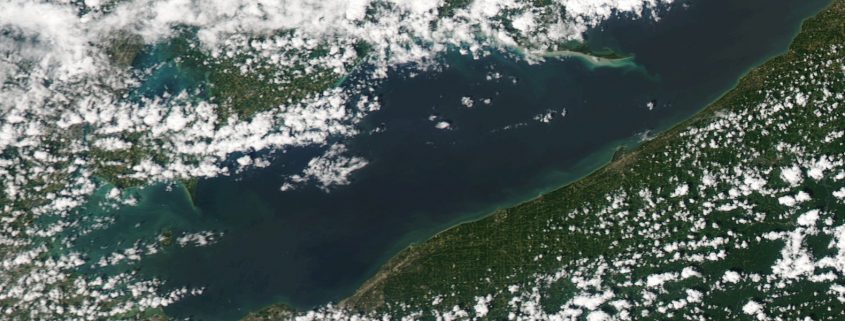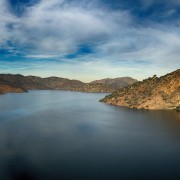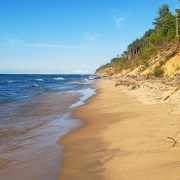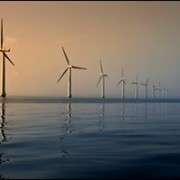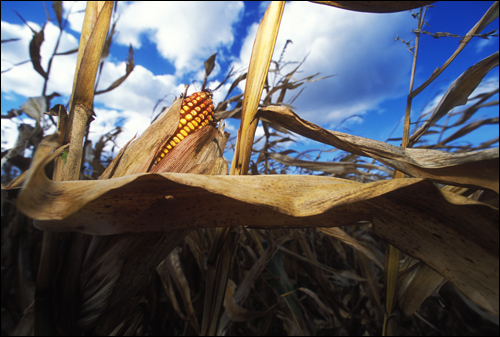Small Lake Erie Algae Bloom Predicted, But Work Isn’t Done
Researchers hone plans to cut phosphorus and mitigate future blooms.
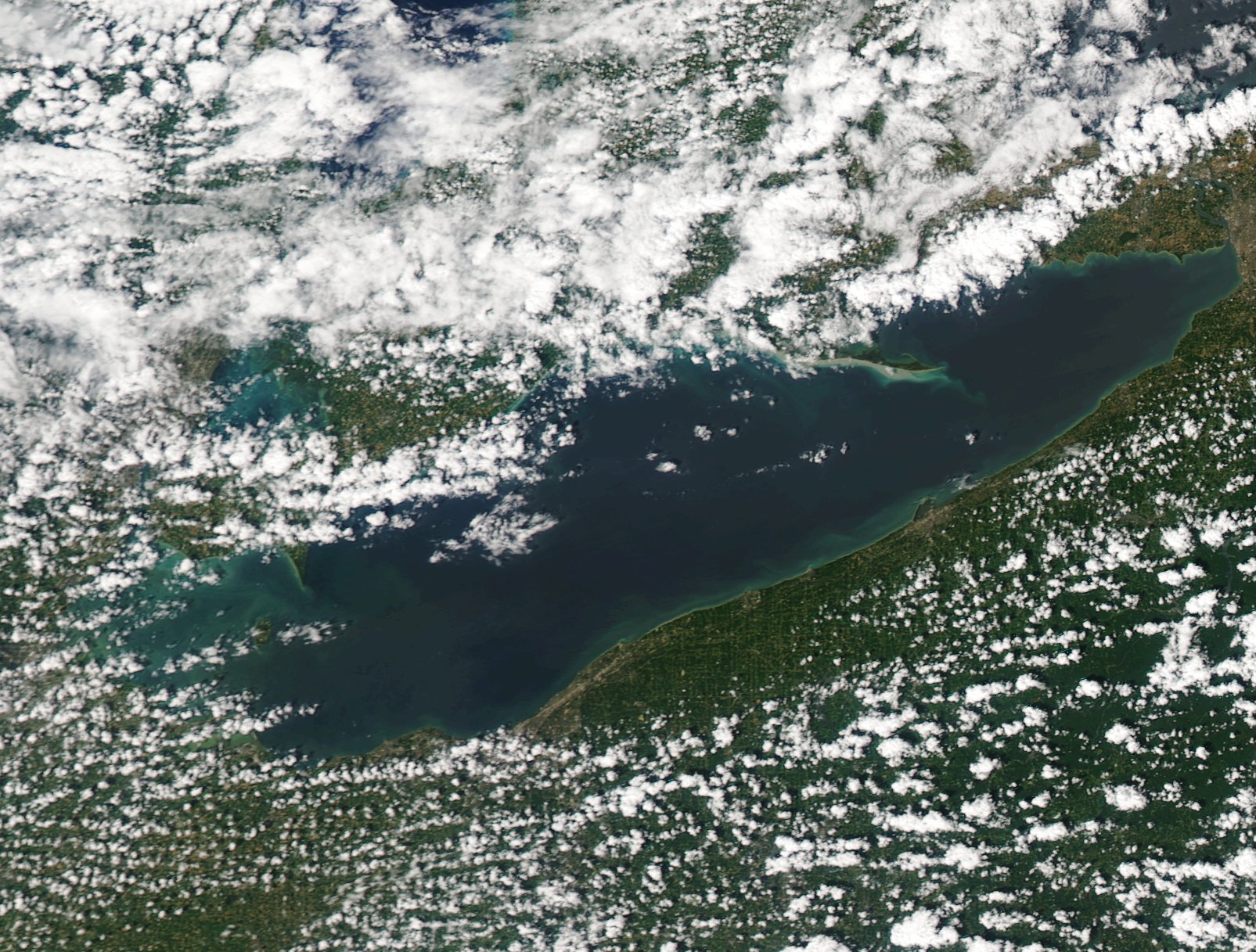
A satellite image captured on July 15, 2016 shows the beginning of an algal bloom. Forecasters predict this summer’s bloom will be much smaller than the record-setting bloom last year. Image courtesy MODIS / NOAA CoastWatch
By Codi Kozacek
Circle of Blue
A year after the most intense bloom of toxic algae on record engulfed Lake Erie, the lake is set to get a reprieve this summer. Federal forecasters at the National Oceanic and Atmospheric Administration predict this year’s bloom will register a 5.5 in severity, about half the level recorded last year and significantly less than the bloom in 2014 that shut down water supplies for nearly half a million people in Toledo, Ohio.
Still, work to rid the shallowest Great Lake from the annual blooms that contaminate drinking water, close beaches, and create aquatic “dead zones” is far from over, warned researchers and water managers gathered at Ohio State University’s Stone Laboratory last week. Hundreds of metric tons of phosphorus, a nutrient contained in fertilizer, manure, and sewage, continue to wash down the Maumee River each year into Lake Erie’s western basin, where the influx fuels the bloom of blue-green algae. The small size predicted for this year’s bloom is more a function of dry weather in the Maumee Basin rather than big reductions in phosphorus. Just as record rains in the basin last year triggered a massive bloom, dry conditions this spring meant less water to carry phosphorus off the land and into the lake. As a result, total “loads” of the type of phosphorus that can be used by algae are expected to be about one-third the amount washed into the lake last year.
“The reality is that rain is really driving our loads at this point in time,” said Laura Johnson, director of the National Center for Water Quality Research at Heidelberg University, which tracks the nutrients flowing into Lake Erie.
That means one dry year with a small algal bloom does not indicate the problem is solved. It will take a 40 percent reduction in the amount of phosphorus flowing down the Maumee and other Lake Erie tributaries to control the blooms in the long-run, according to new targets adopted in February by the United States and Canada. Further, the blooms in Lake Erie are just one facet of the burgeoning nutrient pollution problem across the nation and the globe. Attention this year is focused on the noxious blooms along Florida’s Treasure Coast, where the state’s governor declared a state of emergency in June. But blooms also plague Green Bay in Lake Michigan, Lake Taihu in China, and the Murray-Darling River in Australia. The oxygen-depleted aquatic dead zones created when blooms die regularly form in Lake Erie, the Gulf of Mexico, and the Baltic Sea.
Spurred by the poisoning of Toledo’s drinking water supply in 2014 –and a history of algal blooms dating to the mid-20th century—the research and management efforts being implemented in the Lake Erie watershed to curb phosphorus runoff are an important guidepost for these other systems.
“This is a state, country, and global issue,” said Chris Winslow, interim director of Stone Laboratory. “We’re at the cutting edge of many of these studies right now. A lot of this is going to inform what a lot of people do throughout the country.”
A Plan For Lake Erie
Over the past year, and following decades of study, the Great Lakes states and provinces took their first concrete steps toward curbing phosphorus pollution and algal blooms in Lake Erie. An agreement signed between the premier of Ontario and the governors of Ohio and Michigan last June set an ambitious goal to cut phosphorus flowing into western Lake Erie by 40 percent by 2025. It also set the interim goal of a 20 percent reduction by 2020. The state-level commitment was followed by the adoption in February of 40 percent reduction targets under the Great Lakes Water Quality Agreement. While there is no timeline under the GLWQA, it does require the United States and Canada to develop domestic action plans by 2018 outlining how they will make the phosphorus cuts.
To meet those goals, land and water managers will need to focus on reducing runoff from farms in the Maumee River Basin, according to a study led by researchers at the University of Michigan. While stormwater runoff, discharges from municipal wastewater plants, and septic systems can all contribute phosphorus, scientists estimate nearly 85 percent of the phosphorus flowing into Lake Erie from the Maumee comes from farm fertilizers and manure.
The study, released in April, analyzed a variety of agricultural management scenarios using watershed models to estimate how the practices would affect phosphorus discharges. In general, it found that agricultural practices meant to trap phosphorus on land will need to be widely adopted, and that better results occur when those practices are targeted on land that currently releases high levels of phosphorus.
Specifically, only two scenarios achieved the new targets outlined under the GLWQA. The first would require the conversion of 50 percent of cropland to uncultivated grassland, and is considered highly unrealistic.
The second would require the subsurface application of phosphorus fertilizers on half of the cropland that currently loses the most phosphorus. That prevents the fertilizer from sitting on top of the soil, where it can be washed off by rain. The scenario also calls for the use of rye cover crops and the installation of “medium quality” buffer strips on 50 percent more cropland than implements these practices now. Cover crops store the phosphorus in their roots and leaves, keeping it out of the soil so it cannot wash away, while “buffer” strips of vegetation slow the rain running off of fields, filtering out phosphorus before it reaches streams. As of 2013, approximately 8 percent of farms in the Maumee watershed used a rye cover crop and 35 percent of farms used buffer strips.
In a demonstration of agriculture’s important role in reducing phosphorus, the study also examined a scenario in which all point sources of phosphorus—those that come out of a pipe, such as from a municipal wastewater plant—were eliminated completely. In that scenario, total phosphorus was reduced by just 5 percent, and dissolved reactive phosphorus—the kind most usable by algae—was reduced by 10 percent.
“The 40 percent [target] is doable, but it’s going to be a heavy lift,” said Gail Hesse, director of the National Wildlife Federation’s Great Lakes Water Program, speaking at the Stone Laboratory event. “It’s going to need a steep investment and a steep ramp-up in our efforts to reach that target.”
A news correspondent for Circle of Blue based out of Hawaii. She writes The Stream, Circle of Blue’s daily digest of international water news trends. Her interests include food security, ecology and the Great Lakes.
Contact Codi Kozacek

